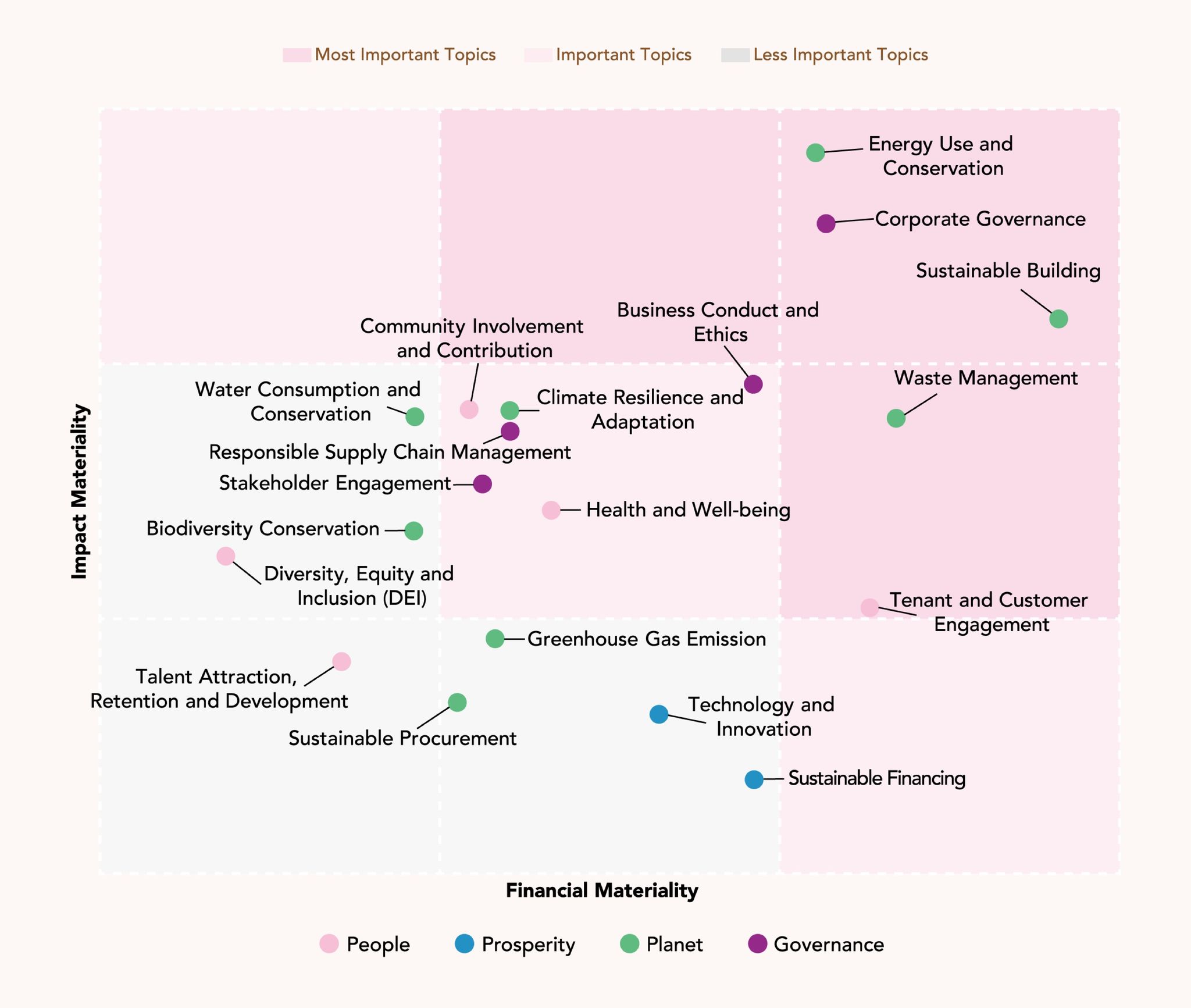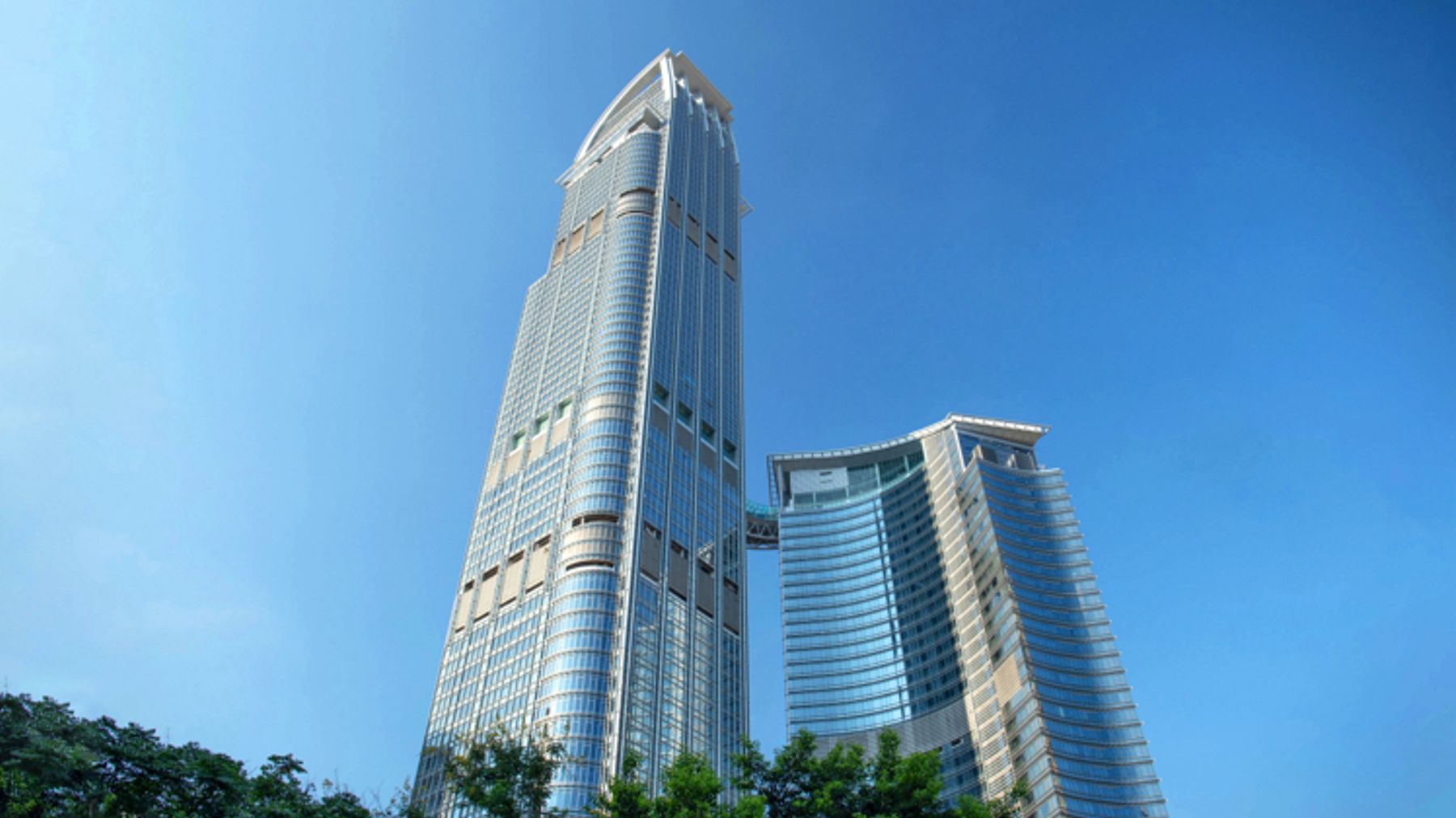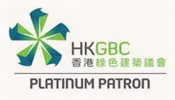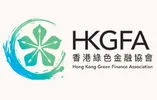Engaging Our Stakeholders and Assessing Double Materiality
Engaging with our stakeholders allows us to understand their expectations about our sustainability initiatives. It also enables us to identify key issues and assess the effectiveness of our sustainability actions.
Channels of Stakeholder Engagement
|
Stakeholders |
Channels |
|
Internal Stakeholders (Colleagues) |
|
|
Hotel Guests and Restaurants Diners |
|
|
Mall Visitors |
|
|
Property Owners |
|
|
Tenants |
|
|
Banks and Financial Institutions |
|
|
Professional Bodies |
|
|
Suppliers, Vendors and Contractors |
|
|
NGOs and Community |
|
|
Government and Regulators |
|
|
Media |
|
|
Joint Venture Partners |
|
|
Academia and Schools |
|
Stakeholders
Internal Stakeholders (Colleagues)
Channels
- Employee survey
- Townhall meeting
- "Chit-chat with CEO"
- Leadership presentation
- Intranet and Viva Engage
- Company website / Social media postings
- Life+ Magazine
- Training sessions
- Stakeholder engagement exercise
- Committee / Work Group meetings
- Colleague engagement events
Hotel Guests and Restaurants Diners
Channels
- Company website / Social media postings
- Front desk and concierge personnel
- Customer satisfaction survey
- Loyalty programme
- Environmental message card
- Life+ Magazine
Mall Visitors
Channels
- Concierge personnel
- Mall events and promotions
- Loyalty programme
Property Owners
Channels
- Company website / Social media postings
- Property management personnel
- Property owner satisfaction survey
Tenants
Channels
- Company website / Social Media postings
- Training sessions
- Stakeholder engagement exercise
- Tenant relationship personnel
- Tenant satisfaction survey
Banks and Financial Institutions
Channels
- Chinachem sustainable finance framework
- Sustainability Report
- Company website / Social media postings
Professional Bodies
Channels
- Sustainability conference
- Regular and special meetings
- Project collaborations
- Organisational memberships
Suppliers, Vendors and Contractors
Channels
- Company website / Social media postings
- Stakeholder engagement exercise
- Tendering and procurement process
- Procurement team personnel
- Sustainability conference
NGOs and Community
Channels
- Sustainability conference
- Community engagement events
- Company website / Social media postings
- Organisational memberships
- Partnering of volunteering events
- Stakeholder engagement exercise
Government and Regulators
Channels
- Sustainability conference
- Community engagement events
- Project collaborations
- Regular and special meetings
- Signatories of government campaigns
Media
Channels
- Media tea gathering
- Company website
- Press release
Joint Venture Partners
Channels
- Sustainability conference
- Project collaborations
Academia and Schools
Channels
- Internship and scholarship
- Collaboration with local university to provide training to colleagues
Comprehensive Stakeholder Engagement and Double Materiality Assessment
During the Reporting Period, the Group conducted a stakeholder engagement and double materiality assessment to understand the impact and financial materiality of ESG topics from the stakeholders’ perspectives, to prioritise the key ESG topics based on stakeholder feedback, as well as gathering valuable insights to inform our sustainability strategy and decision-making.
Step 1: Identification of Potential Material Topics
Referring to the Group’s previous list of strategic topics and drawing on insights from peer benchmarking and industry trends, we updated the list of potentially material ESG topics related to our business and operations.
Step 2: Stakeholder Engagement through Appropriate Channels
To capture stakeholder’s insights, stakeholder opinions were gathered through various methods, including online surveys and in-person focus group discussions.
The Group conducted an anonymous online survey to obtain ratings on the impact and financial materiality of each ESG topic, in addition to collecting opinions on material topics, performance, and areas of improvement. We received a total of 324 responses.
Two internal focus group discussions sessions were held to gain a thorough understanding of the impact and financial materiality of sustainability topics within the context of the Group from stakeholders’ perspectives. 29 individuals from different business units and departments participated and provided valuable insights for the discussions.
Step 3: Ranking ESG Topics by Impact and Financial Materiality
The Group analysed both quantitative and qualitative findings from survey and focus group sessions to establish our new double materiality matrix. The double materiality matrix visualises the relative importance of the ESG topics based on the levels of impacts that the Group could have on the external environment, community, and economy (“Impact Materiality”), as well as the implications of each ESG topic on the financial value of the Group (“Financial Materiality”).
Step 4: Topic Validation and Finalisation
The prioritised material topics and finalised double materiality matrix were reviewed and will be integrated into our strategic planning and decision-making processes.
Double Materiality Matrix
Discussion of Top Material Topics
|
Material Topics |
Impact Materiality |
Financial Materiality |
|
Energy Use and Conservation |
The Group is committed to reducing energy consumption through implementation of various energy efficiency measures, including chiller replacement and adopting energy efficiency technologies in our buildings. Enhancing energy efficiency contributes to carbon reduction and mitigates climate change, accelerating the transition towards a low-carbon economy. These actions not only minimise our environmental impact and conserve resources, but also safeguard ecosystems and promote long-term economic health. |
Rising awareness on climate change in recent years has led to increasing demand for energy efficiency measures to reduce GHG emission. Buildings with energy- efficient features can attract environmentally conscious tenants, comply with energy efficiency regulations, and reduce operational costs over the life cycle of a property. These features could increase property value for our portfolio, contributing to long-term profitability. |
|
Tenant and Customer Engagement |
The Group regularly engages with our tenants and customers, who play a key role in our success. By understanding their needs and concerns, the Group can improve the quality of our products and services, which leads to improved tenant and customer experience. Through addressing our tenants’ and customers’ demand for sustainable product and services, the Group not only satisfies our tenants and customers but also creates positive environmental and social impact. |
With the shifting needs and preferences of our tenants and customers, the Group actively engages with them to understand their expectations. Through addressing their needs, the Group could increase tenant and customer loyalty and satisfaction, and potentially increase recurring revenue for the Group through increased occupancy and demand for buildings. In addition, higher stakeholder participation for the Group’s initiatives could lower cost spent on customer acquisition. |
|
Sustainable Buildings |
By integrating advanced sustainable features in our new projects, including natural ventilation, Building Information Modelling (“BIM”), Modular Integrated Construction (“MiC”), smart IoT systems, and Multi-trade Integrated Mechanical, Electrical, and Plumbing (“MiMEP”), our projects minimise construction waste, lower carbon emissions, reduce noise pollution and contribute to safer working environment. Furthermore, the improved energy and resource efficiency and smart designs of sustainable buildings both minimises our environmental footprint and improves our residents’ wellbeing, contributing to green economy and fostering a more resilient community. |
Sustainable buildings often attract higher market demand from sustainability conscious users and buyers, creating business opportunities and ensuring long- term occupancy and growth. Furthermore, sustainable buildings could reduce operational costs from enhanced energy and water efficiency over the life cycle of a property. Sustainable building certifications help the Group to adhere to evolving building regulations and minimise compliance risks. |
|
Waste Management |
By prioritising waste reduction, recycling, and proper disposal through initiatives such as the REACT Campaign, the Group can minimise landfill use, reduce greenhouse gas emissions, and protect ecosystems from harmful contaminants. These efforts safeguard public health, promote a cleaner environment for all and help to alleviate pressure towards landfills in Hong Kong and contributing to a circular economy. |
The Group expects higher operational costs due to stricter regulations on waste management. New construction methods could help us reduce waste and cost at the same time. For example, MiMEP and MiC methods can lead to reduced manpower requirements and shorter construction durations, potentially lowering operational expenses. |
|
Corporate Governance |
The Executive Committee maintained high standard of corporate governance and oversight, enabling integration of risk and opportunity into strategic decision-making process. By proactively managing risks related to environment, society, and compliance, the Group is committed to environmental and social responsibility. This approach creates positive impact on the environment and community, strengthening positive relationship with various stakeholders. Strong governance also enables sustainable growth for both the Group and the stakeholders it serves. |
Effective risk management is essential for the Group’s sustainable development. It allows the Group to promptly identify, assess, and mitigate a wide range of risks, including operational risk, regulatory risk and market risk. Robust risk management strategies also allow the Group to reduce potential economic loss, safeguard its assets, improve financial return and increase long-term profitability. |
Material Topics
Energy Use and Conservation
Impact Materiality
The Group is committed to reducing energy consumption through implementation of various energy efficiency measures, including chiller replacement and adopting energy efficiency technologies in our buildings. Enhancing energy efficiency contributes to carbon reduction and mitigates climate change, accelerating the transition towards a low-carbon economy. These actions not only minimise our environmental impact and conserve resources, but also safeguard ecosystems and promote long-term economic health.
Financial Materiality
Rising awareness on climate change in recent years has led to increasing demand for energy efficiency measures to reduce GHG emission. Buildings with energy- efficient features can attract environmentally conscious tenants, comply with energy efficiency regulations, and reduce operational costs over the life cycle of a property. These features could increase property value for our portfolio, contributing to long-term profitability.
Tenant and Customer Engagement
Impact Materiality
The Group regularly engages with our tenants and customers, who play a key role in our success. By understanding their needs and concerns, the Group can improve the quality of our products and services, which leads to improved tenant and customer experience. Through addressing our tenants’ and customers’ demand for sustainable product and services, the Group not only satisfies our tenants and customers but also creates positive environmental and social impact.
Financial Materiality
With the shifting needs and preferences of our tenants and customers, the Group actively engages with them to understand their expectations. Through addressing their needs, the Group could increase tenant and customer loyalty and satisfaction, and potentially increase recurring revenue for the Group through increased occupancy and demand for buildings. In addition, higher stakeholder participation for the Group’s initiatives could lower cost spent on customer acquisition.
Sustainable Buildings
Impact Materiality
By integrating advanced sustainable features in our new projects, including natural ventilation, Building Information Modelling (“BIM”), Modular Integrated Construction (“MiC”), smart IoT systems, and Multi-trade Integrated Mechanical, Electrical, and Plumbing (“MiMEP”), our projects minimise construction waste, lower carbon emissions, reduce noise pollution and contribute to safer working environment. Furthermore, the improved energy and resource efficiency and smart designs of sustainable buildings both minimises our environmental footprint and improves our residents’ wellbeing, contributing to green economy and fostering a more resilient community.
Financial Materiality
Sustainable buildings often attract higher market demand from sustainability conscious users and buyers, creating business opportunities and ensuring long- term occupancy and growth. Furthermore, sustainable buildings could reduce operational costs from enhanced energy and water efficiency over the life cycle of a property. Sustainable building certifications help the Group to adhere to evolving building regulations and minimise compliance risks.
Waste Management
Impact Materiality
By prioritising waste reduction, recycling, and proper disposal through initiatives such as the REACT Campaign, the Group can minimise landfill use, reduce greenhouse gas emissions, and protect ecosystems from harmful contaminants. These efforts safeguard public health, promote a cleaner environment for all and help to alleviate pressure towards landfills in Hong Kong and contributing to a circular economy.
Financial Materiality
The Group expects higher operational costs due to stricter regulations on waste management. New construction methods could help us reduce waste and cost at the same time. For example, MiMEP and MiC methods can lead to reduced manpower requirements and shorter construction durations, potentially lowering operational expenses.
Corporate Governance
Impact Materiality
The Executive Committee maintained high standard of corporate governance and oversight, enabling integration of risk and opportunity into strategic decision-making process. By proactively managing risks related to environment, society, and compliance, the Group is committed to environmental and social responsibility. This approach creates positive impact on the environment and community, strengthening positive relationship with various stakeholders. Strong governance also enables sustainable growth for both the Group and the stakeholders it serves.
Financial Materiality
Effective risk management is essential for the Group’s sustainable development. It allows the Group to promptly identify, assess, and mitigate a wide range of risks, including operational risk, regulatory risk and market risk. Robust risk management strategies also allow the Group to reduce potential economic loss, safeguard its assets, improve financial return and increase long-term profitability.













